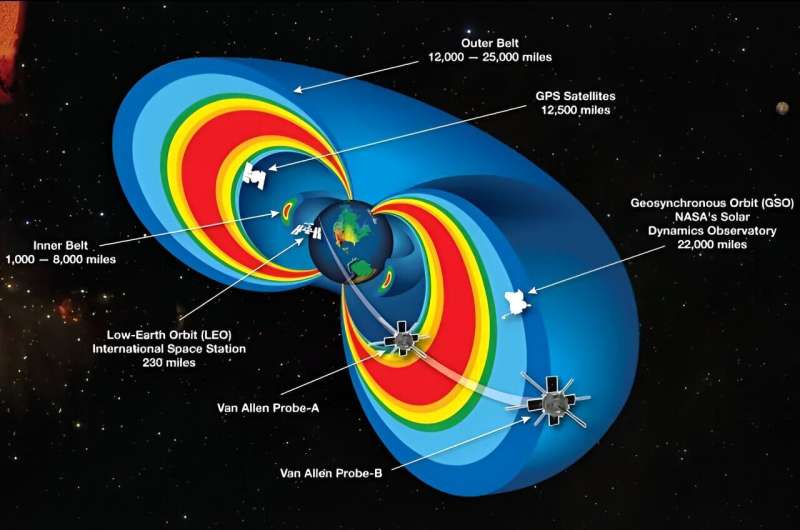
This graphic shows a cutaway model of Earth’s radiation belts as seen by two Van Allen Probes satellites. Credit: NASA illustration
Two University of Alaska Fairbanks scientists have discovered a new type of electromagnetic wave called a „whistler” that carries significant amounts of lightning energy into Earth’s magnetosphere.
Research is Published today in Scientific advances.
Emeritus Professor Vikas Sonwalkar and Assistant Professor Amani Reddy discovered a new type of wave. The wave carries lightning energy, which enters the ionosphere at low latitudes, to the magnetosphere. The energy is reflected upward by the lower boundary of the ionosphere at an altitude of about 55 miles in the opposite hemisphere.
It was previously believed that lightning energy entering the ionosphere at low latitudes did not reach the radiation belts because it was trapped in the ionosphere, the authors write. The belts are two layers of charged particles that surround the planet and are held in place by Earth’s magnetic field.
„We as a society are dependent on space technology,” Sonwalkar said. „Modern communication and navigation systems, satellites and spacecraft carrying astronauts are exposed to harmful energetic particles from the radiation belts, which can damage electronics and cause cancer.
„Radiation belts and a variety of electromagnetic waves, including those that appear in terrestrial lightning, and their impact are vital to human activity in space,” he said.
Sonwalkar and Reddy’s discovery is a type of whistler wave they call a „specularly reflected whistler”. Whistle sounds when played through speaker.
Lightning energy entering the ionosphere at high latitudes reaches the magnetosphere as a variety of whistles known as magnetospheric reflection whistles, which undergo one or more reflections in the magnetosphere.
The ionosphere is a layer of the Earth’s upper atmosphere characterized by a high concentration of ions and free electrons. It is ionized by solar radiation and cosmic rays, making it conductive and important for radio communication as it reflects and modulates radio waves.
Earth’s magnetosphere is the region of space surrounding the planet and formed by Earth’s magnetic field. It provides a protective barrier that prevents most particles of the solar wind from reaching the atmosphere and harming life and technology.
Sonwalkar and Reddy’s research shows that two types of whistlers — specularly reflected whistlers and magnetospherically reflected whistlers — coexist in the magnetosphere.
In their research, the authors used plasma wave data from NASA’s Van Allen probes, which launched in 2012 and ran until 2019, and lightning data from the Global Lightning Detection Network.
They developed a wave propagation model that showed a doubling of lightning energy reaching the magnetosphere when specularly reflected whistlers were considered.
A review of plasma wave data from the van Allen studies shows that specularly reflected whistles are a common magnetospheric phenomenon.
Most lightning occurs in low latitudes, which are tropical and subtropical regions prone to thunderstorms.
„This indicates that whistlers reflected in the magnetosphere transport most of the lightning energy into the magnetosphere,” Sonwalkar said.
The impact of lightning-generated whistler waves on radiation belt physics and their use in remote sensing of magnetospheric plasma have been researched since the 1950s.
Sonwalkar and Reddy are from the Department of Electrical and Computer Engineering at the UAF College of Engineering and Mines. Reddy is affiliated with the UAF Institute of Geophysics.
Sonwalkar and Reddy’s research was supported by grants from the National Science Foundation and NASA EPSCOR, an established program to stimulate competitive research.
More information:
Vikas S. Sonwalkar et al., Specularly Reflected Whistler: A Low-Latitude Channel to Couple Lightning Power to the Magnetosphere, Scientific advances (2024) DOI: 10.1126/sciadv.ado2657
Quotation: Scientists Discover Phenomenon Impacting Earth’s Radiation Belts (2024, August 17) Retrieved 17 August 2024 from https://phys.org/news/2024-08-scientists-phenomenon-impacting-earth-belts.html
This document is subject to copyright. No part may be reproduced without written permission except for any reasonable manipulation for the purpose of personal study or research. Content is provided for informational purposes only.

„Oddany rozwiązywacz problemów. Przyjazny hipsterom praktykant bekonu. Miłośnik kawy. Nieuleczalny introwertyk. Student.
